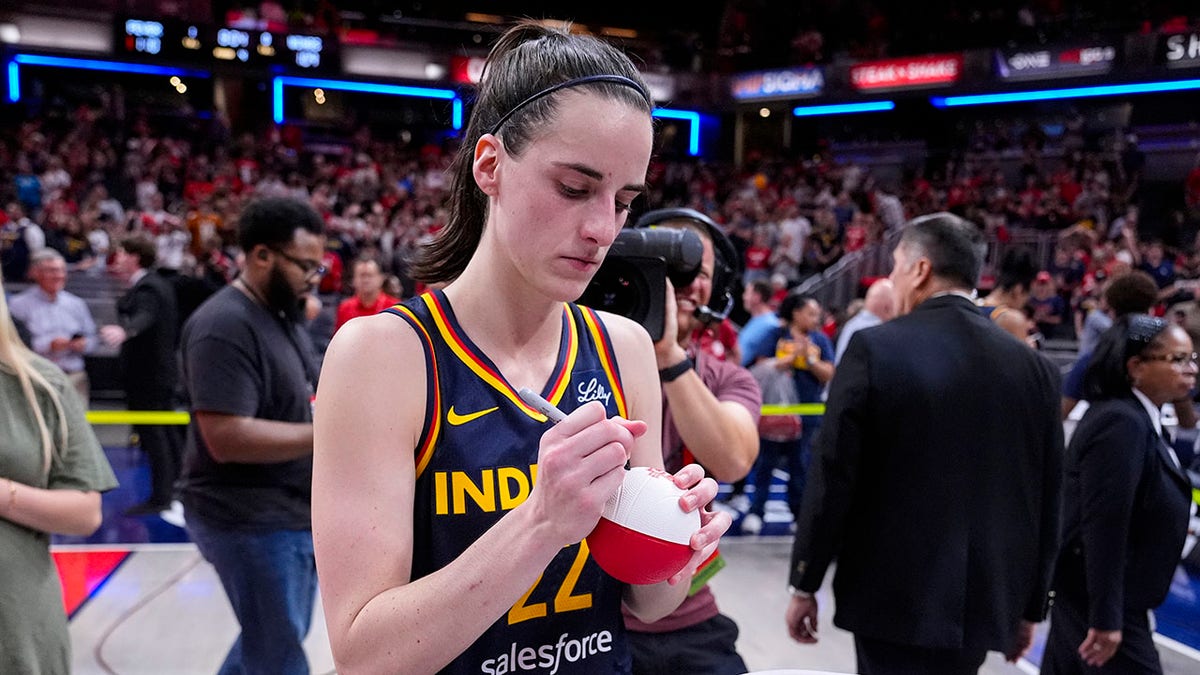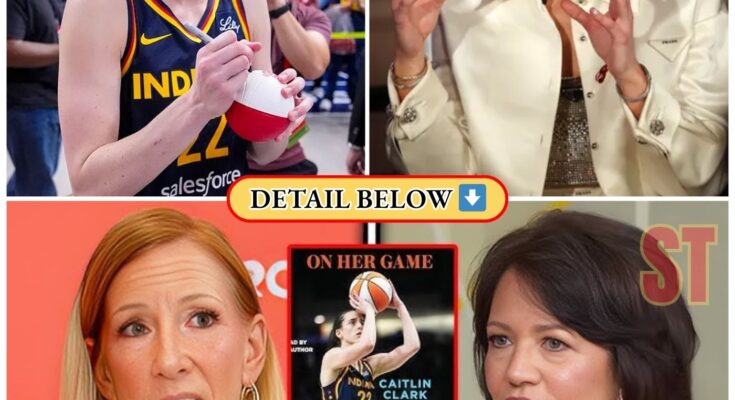At exactly 9:42 AM on a quiet Tuesday, a senior WNBA executive slammed her laptop shut. The Amazon charts had just updated.

And Caitlin Clark’s unauthorized biography — the one she didn’t write, didn’t promote, and didn’t endorse — was now the #1 bestselling book in America.
Within hours, internal emails were circulating across league offices.
Subject line: “Crisis Comms: Brennan Book Fallout.”
What was supposed to be a celebration of Clark’s historic rookie season had become a siren — one loud enough to rattle the league to its core.
She Stayed Silent. The Book Did Not.
The author, Christine Brennan, is no tabloid opportunist. She’s a veteran journalist with seven books and 21 Olympic Games under her belt. She’s known for reporting on power — especially the kind that hides behind professionalism and platitudes.
And what she wrote this time didn’t just raise eyebrows.
It exposed fault lines.
Brennan didn’t set out to write a scandal. She set out to chronicle a phenomenon. But what she uncovered — through interviews with players, agents, arena staff, media insiders, and unnamed WNBA executives — was far messier than anyone imagined.

“I thought I was documenting history,” Brennan told one colleague.
“Instead, I uncovered what the league never wanted to admit.”
The League’s Biggest Moment — And Its Most Public Failure
Caitlin Clark had just finished the most watched college basketball career in NCAA history. Her highlights were viral. Her jersey sold out in minutes. Her impact reached countries that had never cared about the WNBA before.
And yet, according to Brennan’s sources, the league had no plan.
“They weren’t ready for her,” one marketing executive admitted anonymously.
“They thought she’d be a nice bump. Not a cultural earthquake.”
That miscalculation shaped everything that followed: the media tensions, the locker room hostility, the lack of physical protection, and eventually — the Olympic snub heard ‘round the world.
The Olympic Snub: A Tipping Point
One of the book’s most damning revelations comes from a conversation Brennan had just days after Clark declared for the WNBA Draft.
A representative from Clark’s camp contacted USA Basketball — not to lobby, but to ask:
“Do you understand what’s about to happen?”
The response?
“We think it’s comparable to when Maya Moore entered the league.”
That moment became a throughline in Brennan’s reporting — not because it was disrespectful, but because it was catastrophically insufficient.

Clark wasn’t just another star.
She was a once-in-a-generation media engine. A $1 billion economic force, according to some sports economists. A name recognized in countries where basketball isn’t even televised.
And they missed it.
The Collapse: One Week After the Book’s Release
Seven days after the book hit #1 on Amazon, internal documents from a major WNBA partner leaked to the press.
They showed a quiet but deliberate shift in the league’s advertising materials:
Clark’s image was reduced by over 80%.
No statement.
No announcement.
Just a visual rollback — as if pretending she wasn’t central to the league’s visibility might somehow reduce the noise.
It didn’t.
The internet noticed.
And the backlash made it worse.
Brennan Almost Walked Away
In one of the book’s more emotional sections — which didn’t make headlines but struck a chord with early readers — Brennan recounts the moment she nearly scrapped the entire project.
Clark wouldn’t speak.
League PR departments were stonewalling.
Anonymous sources were nervous.
“There were nights I stared at the manuscript and thought, ‘Why am I doing this?’” Brennan wrote in her author’s note.
But the silence, she realized, was the story.
Clark wasn’t fighting for attention.
She didn’t need to.
Because the world was watching — and everyone else was flinching.
Inside the Pages: A League Unprepared, Players Divided
The book doesn’t make Clark a victim. Nor does it paint her critics as villains. But it does reveal the undercurrent of resentment, fragility, and fear within a system that wasn’t designed to handle an athlete of this scale.
Some veteran players refused to speak on the record.
Others made veiled comments in pressers.
One told Brennan: “She hasn’t earned it yet. She hasn’t been hit enough times.”
Brennan didn’t editorialize. She just let the quotes speak.
And the contrast was striking:
Clark, being hit — literally and metaphorically — while quietly leading the league in minutes, assists, and endorsements.
When the World Showed Up, the WNBA Panicked
Brennan devotes nearly an entire chapter to Clark’s international reach:
Fans flying in from Hawaii, Mexico, Canada, France, and even Japan just to attend a game.
Ticket sales quadrupling overnight when Clark was scheduled to appear.
Cities moving entire games to NBA-sized arenas to accommodate “Clark-only” crowds.
One arena security guard told Brennan:
“I had three people cry when she walked past them. Like she was The Beatles.”
This wasn’t just basketball anymore.
This was global.
And the WNBA’s infrastructure — both logistically and emotionally — was still stuck in 2017.
A Star They Used But Didn’t Protect
Perhaps the most uncomfortable revelation in Brennan’s book is how the league leaned on Clark’s fame without ever fully protecting her — physically or politically.
From Day 1, Clark endured:
Flagrant fouls
Cheap shots
And almost no calls in her defense
Her teammate Sophie Cunningham became her unofficial bodyguard, telling Brennan off record:
“If they won’t blow the whistle, we’ll set the tone ourselves.”
Meanwhile, league spokespeople continued to deny that any special treatment was warranted.
But the numbers — again — told a different story:
Viewership dropped 53% when Clark was injured.
Her jersey accounted for 60% of all WNBA merchandise sales.
And without her, games in several cities played to half-empty seats.
She was the engine.
And the league treated her like a luxury item — not the power source.
She Didn’t Talk. But the Book Did.
What sets Brennan’s book apart isn’t just the data. It’s the silence.
Clark never responded. Never gave quotes. Never pushed back.
“She looked me in the eye once,” Brennan writes in the final chapter.
“It was during warmups, before a game. I wasn’t sure if she knew who I was. But in that look, I saw everything.
Not approval. Not rejection.
Just understanding.”
That moment — frozen in a single paragraph — says more than a dozen press releases ever could.
Because Clark didn’t have to write the book.
She didn’t even have to open her mouth.
The world filled in the silence.
Now the League Is Learning the Hard Way
Since the book’s release:
Sponsors have started asking questions about how the league handled Clark’s rise.
TV partners are demanding more Clark-centered content to justify contracts.
Even foreign sports networks have begun licensing Clark games specifically — ignoring the rest of the league schedule.
And as Team USA heads to Paris without her, that silence is louder than ever.
“You know who’s not there,” one fan tweeted.
“And you know why.”
This Was Never Just About a Book
This wasn’t a biography.
It was a reckoning.
Christine Brennan thought she was writing a sports story.
She ended up exposing a leadership crisis.
A cultural panic.
And a league that still can’t decide if it wants to grow or stay small enough to manage.
Caitlin Clark didn’t need this book to prove anything.
But the fact that it now sits atop bestseller lists — despite zero promotion, zero cooperation, and zero commentary from its subject — proves one thing beyond doubt:
She didn’t just change the game.
She changed the way it gets told.
Disclaimer: This article is based on the published work “Caitlin Clark and the Revolution in Women’s Sports” by Christine Brennan, public domain data, and extensive secondary research. Select narrative elements and timelines have been editorially shaped for clarity, consistency, and journalistic structure.

